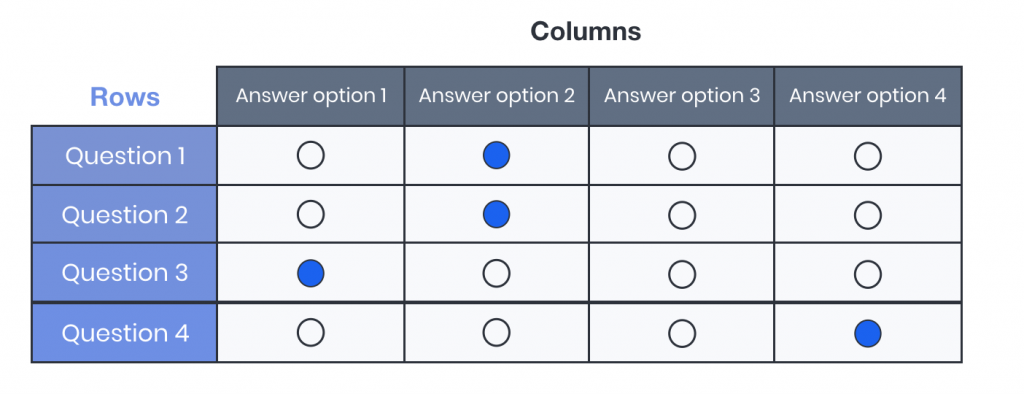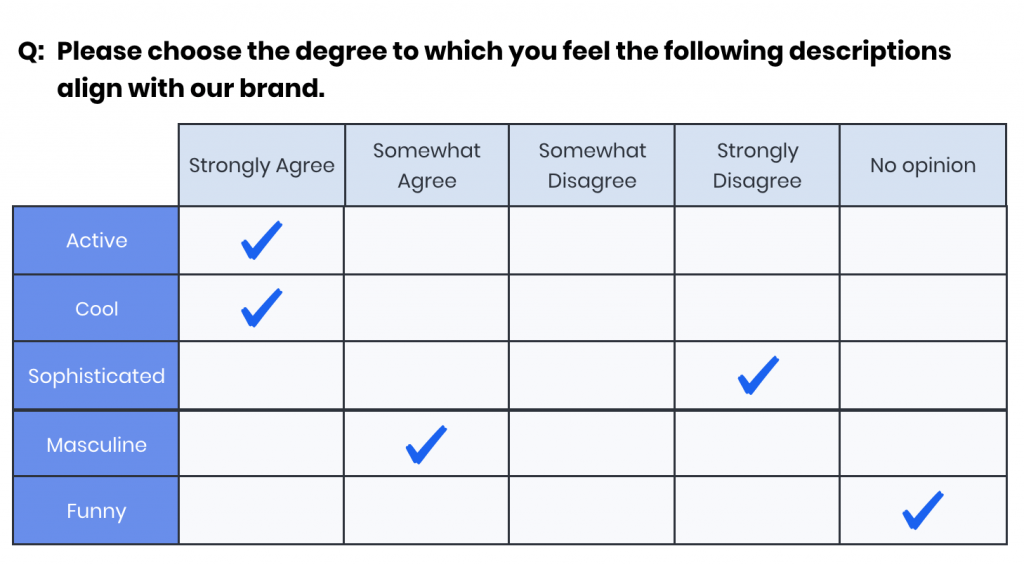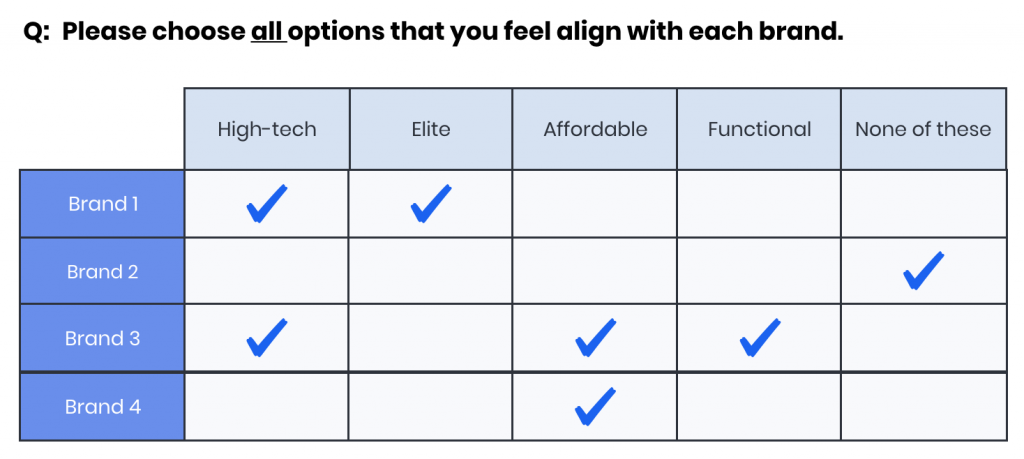How to Use Various Matrix Questions (Updated)
A Matrix question is a group of multiple-choice questions displayed in a grid of rows and columns. The rows present the questions to the respondents, and the columns offer a set of predefined answer choices that apply to each question in the row. Very often the answer choices are on a scale.

When to use Matrix Questions
It is best to use Matrix questions when asking several questions in a scaled format about a similar idea. They can be applied either as a mini-survey on their own or as a single-question type within a larger questionnaire. The closed-ended, predefined answers that apply to a series of questions make Matrix questions great for:
- Customer experience/satisfaction surveys.
- Questions about a subtopic in a larger questionnaire.
- Combining many rating-scale questions in a more digestible format.
Customer experience surveys
Matrix questions are commonly used in customer experience surveys. For example, to ask a respondent about their experience on a flight, the rows might ask the respondent about the service, food, or entertainment while the columns ask them to choose a rating response.

Questions about a subtopic
Oftentimes a questionnaire includes many ideas, but some of them are specific to a subtopic within that survey. Matrix questions are an effective way to cluster these ideas into a format the respondent can easily understand.
For example, in a brand awareness survey, a customer might use a matrix to get more information on brand perception.

Benefits of Matrix Questions
The format and structure of Matrix question types supply some unique benefits. Because it is a series of questions presented as a single table, it appears as a single question on the survey. This has the benefit of saving space (both on paper and in a digital survey) as well as reducing drop-offs from respondents who do not want to answer five nearly identical questions back-to-back.
The grid is easy and intuitive for respondents to follow with closed-ended, predefined answer sets, which means quick responses and a clear, easy-to-analyze dataset as the outcome.
Drawbacks of Matrix Questions
While there are many benefits, there are a few things to keep in mind when using Matrix questions.
The table formatting, while easy for respondents to answer, can also result in activities such as “straight-lining” or other pattern-making within the table.
Another issue can be the addition of too many rows or columns, which may negatively affect the data quality. If there are too many choices, respondents might lose interest (and be more likely to enter insincere answers to move quickly through it). In some cases, this can affect formatting as well, particularly in a digital survey environment such as mobile. If the Matrix question is not designed for an optimal mobile user experience, it can be confusing or frustrating for respondents.

Some survey companies will also charge for each row in the Matrix, as though they are individual questions, which may change the cost of the overall survey. Keep this in mind when building your questionnaire. (Pollfish views Matrix questions as a single question type, so pricing does not vary based on the number of rows and columns included).
Types of Matrix Questions: Single- Selection vs Multiple-Selection & Multiple Matrices
Matrix questions, like regular multiple-choice questions, can be either single-selection or multiple-selection. This means that a respondent can choose either a single answer choice per row or they could choose multiple answer choices per row.
Competitive analysis surveys might include Matrix questions to better understand how a product or brand is measuring up against competitive offerings.

Exclusive Answers for Multiple Matrices
You can create exclusive answers from the scale points of multiple matrices.
As we realize the need to allow researchers to mark answers as exclusive in a Matrix table, you can do so by using the Multiple Selection question type.
Here’s how it works: when a respondent selects a specific scale point as an answer to a statement, all the other scale points become de-selected, much like in the exclusive answers in the Multiple selection question type. Thus, the scale point marked as “exclusive” is an exclusive answer for every statement.
Keep the following in mind: after starting the survey, the respondents cannot modify any exclusive answer flag. You can make multiple scale points become exclusive.
How Matrix questions differ from a Likert Scale
Many people believe that a matrix question is just a Likert scale, when in fact, it is the other way around.
A Likert Scale is a specific type of Matrix question designed to measure opinions linearly. Using a 5- or 7-point scale to collect user sentiments, a Likert Scale can be used to determine scaling attitudes such as:
- Agreement (Strongly Agree- Strongly Disagree)
- Likelihood (Very Likely- Not very likely)
- Importance (Very Important- Unimportant)
- Frequency (Always- Never)
- Quality (Excellent- Poor)
A Matrix question is a format for the question, meaning it is presented in a grid (or matrix). While Matrix questions often happen to be Likert Scales, Matrix questions can also be applied across a variety of use cases outside of attitudinal measurement, as shown above.
Best practices for writing a good Matrix question
Writing a good Matrix question follows many of the same best practices for writing good survey questions in general. However, due to the grid formatting, there are a few other things to be aware of.
- Limit the number of rows or columns. Keep it around five different options for questions and answers so as not to bore or overwhelm respondents.
- Give respondents a way to opt-out of things they are not familiar with, such as a “no opinion” or “neutral” answer choice.
- Do not make the questions too long. In the table format, long questions create a poor respondent experience.
- Try to group like-concepts. For example, if you want to know about brand perception, keep the questions related to that subtopic.
- As in any closed-ended scaling question type, keep scaling answer choices in order so as not to confuse the respondent.
Matrix question types are available in the “questionnaire” section of the Pollfish survey builder. Sign in or create an account to get started on your next survey.
Frequently asked questions
What is a Matrix question?
A matrix question is a group of multiple-choice questions displayed in a grid of rows and columns. The rows present the questions to the respondents, and the columns offer a set of predefined answer choices that apply to each question in the row. Very often the answer choices are offered in a scale.
When do you need to use Matrix questions?
Matrix questions are best used as to ask several questions about a similar idea when there is a scale involved. They can be used either as a mini-survey on their own, or as a single question type within a larger questionnaire.
What kinds of surveys and contextual questions are Matrix questions good to use for?
Matrix questions are great to use for closed-ended, predefined answers that apply to a series of questions. These are appropriate for customer experience/ satisfaction surveys, questions about a subtopic in a larger questionnaire and for making rating-scale questions more digestible.
Are Matrix questions a type of Likert scale?
It's the other way around. A Likert Scale is a type of matrix question that is designed to measure opinions in a linear fashion. Using a 5 or 7 point scale to collect user sentiments, a Likert Scale can be used to determine scaling attitudes.
What are the two types of Matrix questions?
Matrix questions can be either single-selection or multiple-selection. This means they can either be a single answer choice per row, or they could choose multiple answer choices per row. These might be used in competitive analysis surveys to understand how a product or brand is faring against competitive offerings.
Frequently asked questions
What is a Matrix question?
A matrix question is a group of multiple-choice questions displayed in a grid of rows and columns. The rows present the questions to the respondents, and the columns offer a set of predefined answer choices that apply to each question in the row. Very often the answer choices are offered in a scale.
When do you need to use Matrix questions?
Matrix questions are best used as to ask several questions about a similar idea when there is a scale involved. They can be used either as a mini-survey on their own, or as a single question type within a larger questionnaire.
What kinds of surveys and contextual questions are Matrix questions good to use for?
Matrix questions are great to use for closed-ended, predefined answers that apply to a series of questions. These are appropriate for customer experience/ satisfaction surveys, questions about a subtopic in a larger questionnaire and for making rating-scale questions more digestible.
Are Matrix questions a type of Likert scale?
It's the other way around. A Likert Scale is a type of matrix question that is designed to measure opinions in a linear fashion. Using a 5 or 7 point scale to collect user sentiments, a Likert Scale can be used to determine scaling attitudes.
What are the two types of Matrix questions?
Matrix questions can be either single-selection or multiple-selection. This means they can either be a single answer choice per row, or they could choose multiple answer choices per row. These might be used in competitive analysis surveys to understand how a product or brand is faring against competitive offerings.
Pollfish Marketing Team
Ready to Try Pollfish?
Create your survey with AI, target high-quality respondents starting at $0.95 per complete, and start getting results in just minutes in real-time. From running a simple product concept survey to managing a constant stream of trackers for dozens of clients in dozens of countries, we’ve got you.
